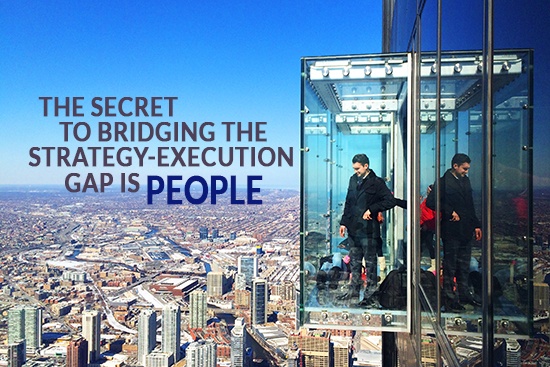As leaders, we each bring value to the world in our own distinct way. The uniqueness of the start of our leadership journey is extraordinary as we are born into the world and then move out to engage it, seeking to have impact, hoping to make friends, longing to achieve results, and aspiring to make a difference.
However, we can find profound similarities among us all in our calling to serve. Several fundamental challenges are consistent across our individual leadership journeys. One of these common leadership challenges is learning how to translate vision into reality. Or, as we more usually say it: How can we bridge our strategy-execution gap?
In the often-quoted Forbes research on this subject, it was found that “82% of Fortune 500 CEOs feel their organization did an effective job of strategic planning. Only 14% of the same CEOs indicated that their organization did an effective job of implementing the strategy."
Crawling deeper into the data, the average achievement of successful execution hovers between 50% to 60% of what the plan was designed to achieve. This goes beyond, now, how the executives feel about their capacity to execute and captures how the organizations actually performed in relationship to their plans. And, as we begin to uncover what some of the top reasons are for this performance breakdown – or rather, this underperformance in strategy execution – the reasons all point back to underperformance in leadership.
[Tweet "The top reasons for performance breakdown all point back to underperformance in leadership."]
True story: The leadership at a medical technology company asked me to help them with their skyrocketing legal bills. Wrongful termination lawsuits, which the company tended to lose, were creating significant drag on focus, not to mention resources. New employees were being terminated just 6-12 months after they were hired. The quickly removed employees would then sue the company, and they tended to win. It was happening a lot.
I asked the CEO what he wanted me to do for him, and he suggested that I design a system to train their managers to document performance infractions; failures to meet the standards of quality and speed the company required. In short, he asked that we put better paper into the files so that at the point of termination the company would be equipped to successfully defend the suits.
I asked the CEO to describe the training, the supervision, the management, and the review processes they had in place. He told me that they hired top candidates only – men and women who should know what they’re doing. They hired them, watched them for a while, and then fired them when they didn’t meet the grade.
I asked the CEO if I could, alternatively, train his managers how to train the workers effectively. To train his managers how to delegate tasks and responsibilities, and appropriately follow up in a constructive manner so their people could learn from them, do a better job, and grow and succeed. I noted that what I would teach his managers would also provide all the paper in the world so that non-performers could show themselves to be non-performers in clear black and white.
The CEO told me that he thought that sounded time-consuming – learning how to grow people so they could achieve and excel – and all he needed was better documentation skills to sort out the dullards. He was going to get the people he needed by continuing to hire.
I told the CEO that I would be unable to help him get better. I also told him that the moment his competitors figured out how to bring a product to the market that could go toe-to-toe with his patent-holding advantages – which in the grand scheme of things, would take about a New York minute – his company would be done. He blinked at me uncomprehendingly.
Another true story: Industrial Scientific Corporation was founded by Kent McElhattan, a man who believed that his company's secret to success would be found in what he called their “people competitive advantage.” Kent, along with his son, Justin McElhattan (the current CEO), and their entire leadership team worldwide understand that the secret to bridging the strategy-execution gap is people. Growing people, including the input of people, valuing people, listening to people, and winning the trust and the full engagement of people.
Industrial Scientific has moved into first place in the world in the gas detection industry, and they did so by understanding that bridging the strategy-execution gap required mastering certain leadership behaviors and skills. Kent once told me, “If I had to choose between a people competitive advantage, a technology competitive advantage, or a strategy competitive advantage, that’d be easy. I’d pick the people competitive advantage every time.”
[Tweet "Getting from vision to reality demands great people, and great people must be developed and nurtured. "]
Getting from vision to reality demands great people, and great people must be developed and nurtured. Great people also must be earned as a product of our leadership. Let me say it differently: We must learn how to exhibit, with discipline, the right leadership behaviors if our objective is to grow and win great people. Only then will we have the capability and confidence to successfully execute our organization’s strategy and turn our greater vision into reality.
John Stahl-Wert is co-author of the best-selling book "The Serving Leader." He serves as President of Newton Institute and Director of its Center for Serving Leadership. Learn more at www.centerforservingleadership.com.
Photo by Josh Newton (Man on the edge, Chicago, Ill.)


